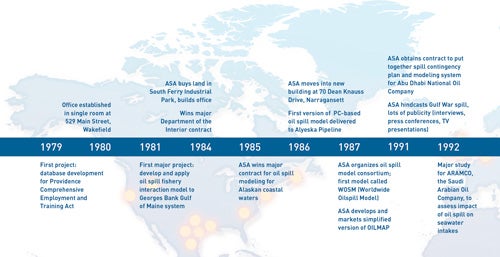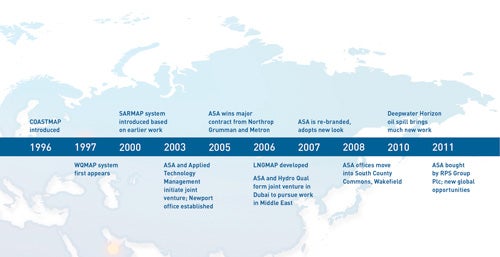Start-up to Success

How a tiny business venture launched by URI-trained minds developed over three decades into a global leader
Within days of the explosion of the Deepwater Horizon oil drilling rig in the Gulf of Mexico in 2010, Deborah French McCay, Ph.D. ’84, and dozens of other URI alumni who work for Applied Science Associates (ASA) in Wakefield were hard at work monitoring the spill and preparing to travel to the Gulf. They spent the next few months coordinating a rapid assessment of the marine and coastal environment for the federal government, determining pre-spill conditions and collecting data on the harm the spill caused.
Nearly three years later, about 15 of the company’s staff are still working full time on the project, comparing the before and after data. The resulting documentation will be used by government attorneys to build a case against the responsible parties for payment of damages.
ASA is one of only a handful of companies around the world to work closely with governments and the oil industry to monitor and predict the movement of spilled oil in the environment and to assess its damage.
“In the last 20 years, we’ve responded to every major oil spill in the world on somebody’s behalf,” said Malcolm Spaulding ’69, Ph.D. ’73, professor emeritus of ocean engineering and a co-founder of the company. “We have a contract with the National Oceanic and Atmospheric Administration to provide support for all spills in the U.S. that reach natural resource damage assessment level. So we are always on call.”
In the 1970s, Spaulding and his graduate students were creating numerical models on early computers to study water pollution in Narragansett Bay. A grant from the Department of Energy led them to study the effects of oil and oil dispersants on fisheries and the marine environment. One result was a model that predicted where an oil spill would travel based on winds, currents, and other conditions. It was the first oil spill model of its kind, which led to contracts with the government to study the potential effects of an oil spill on the continental shelf.
In 1979, Spaulding, along with Engineering Professor Emeritus Frank White, Oceanography Professor Peter Cornillon, and then-graduate student J. Craig Swanson, M.S. ’76, Ph.D. ’87, turned this research into ASA, which started with one employee, Swanson. The company grew quickly, and by the end of 1980 it employed a half dozen people, mostly URI graduates.
“The oil spill focus was the vehicle that got us going and was most critical to our ultimate success, but my focus was on water quality,” said Swanson, whose expertise at computer modeling was indispensible. “We had developed these tools that make predictions of where oil would move to, based on currents and tides, and we used the same kind of models to predict pollutant transport. We did a lot of work with the Narragansett Bay Commission as it was designing a system to control combined sewage overflows into the Bay, helping them evaluate the water quality benefits of various options.”
That work continued through the 1990s, but it has shifted in recent years to focus on thermal pollution from power plants—the movement of warm water discharged by the facilities into waterways and its effect on the marine environment. In addition to his computer modeling work, Swanson has had a lead role in business development and establishing relationships with public agencies and engineering firms.
But it’s the oil spill work that gets the most attention.
“In the oil spill business, you need to know where it’s going to go and when it’s going to get there, with the goal of knowing what can be done to respond and protect resources,” explained Spaulding. “In the Middle East, for instance, goal number one is to keep the oil out of the desalination facilities or else they’ll have no drinking water. In most other places the goal is to protect the environment.”
Around the time of the first Gulf War, the company ran oil spill simulations in the Arabian Gulf for the governments of Saudi Arabia and the United Arab Emirates to assess how vulnerable their desalination plants were, and it was heavily involved in a variety of projects following the Exxon Valdez oil spill in Alaska in 1989, the North Cape spill off Rhode Island in 1996, and the Prestige spill off the coast of Spain in 2002.
“Ultimately, someone needs to know how much damage the spill has done to the natural resources,” said Swanson. “Deborah French McCay has been instrumental in developing that for us. She brought the skill of using computer models to predict what the biological impacts were going to be. How long does it take the fish and other organisms to recover? That opened up a lot of work for us.”
The oil transport model has also been adapted for use as a tool for search-and-rescue operations to track the likely movement of people or vessels or cargo that have been lost at sea. It is used by the U.S. Coast Guard and similar agencies in six other countries, and in Rhode Island it helped find a fishing boat adrift off Block Island and a plane that disappeared after taking off from Westerly, among others.
All this work has transformed ASA from a tiny start-up with initial capitalization of $3,200 into a global leader with 60 employees in Rhode Island (31 of whom graduated from URI, including company president Eoin Howlett, M.B.A. ’02) and annual revenues of $12 million, making it one of the largest companies to spin-off from research started at the University.
In 2011, ASA was bought by a British company, RPS Group plc, which operates 80 offices around the world with a total of about 5,500 employees. The parent company provides broad oversight, and has provided ASA numerous growth opportunities. As a result, Spaulding said ASA has been growing by about one new employee every month since the acquisition, and it is outgrowing its fourth office location.
“We have a notice on our website all the time listing jobs that are available,” he said. “We’re up to our ears in stuff to do, and we’re looking for good people.”
As it grows, the company is expanding its products and services. It is building a version of its oil spill model for land-based pipelines and considering another version to address the catastrophic failures of oil storage tanks. The company is also using its skills to support the emerging field of offshore wind and wave energy development.
“We’ve been true to the vision that we originally had—it’s an engaging place to work, we work on interesting problems, we’re participating at the leading edge of our field, and we have a healthy and thriving organization,” concluded Spaulding. “And by hiring so many alumni and regularly contracting with faculty, we think we provide a real value to the University.”
–Todd McLeish
On June 2012, two ships collided in Yangtze Estuary. One ship spilled over 100 tons of oil. Chinese government agencies used ASA’s OILMAP system to simulate the spill trajectory and fate of the spill. The model simulation results matched extremely well with the field data observed by the local responders.
Read more about URI’s efforts to boost business ventures on campus and throughout the state: see “Springboard for Entrepreneurs” on page 6.
 Home
Home Browse
Browse Close
Close Events
Events Maps
Maps Email
Email Brightspace
Brightspace eCampus
eCampus



